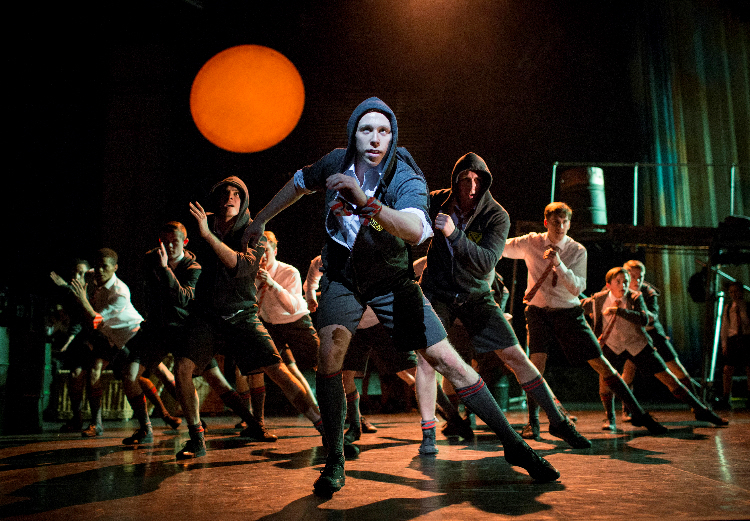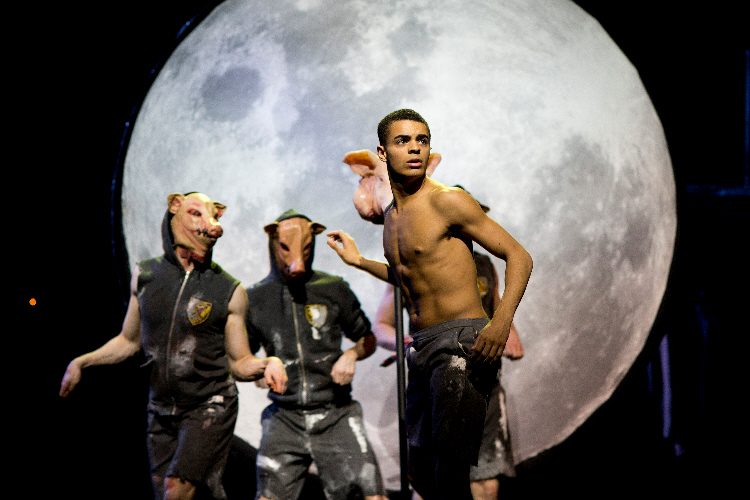The music reaches a deafening crescendo and is abruptly silenced as the entire theatre is plunged into darkness. The stage is shrouded in smoke from which emerge a group of schoolboys, harmonising in the style of a male choir. The performance has begun and it promises to be dramatic.
However, the most exciting aspects are not limited to the show itself but also to the thrilling opportunity which has been created through the collaboration of Wales Millennium Centre and Matthew Bourne’s New Adventures and Re:Bourne. For this cast is not made up of seasoned professionals but instead is comprised of 24 young males from Wales and the South West, ranging from trained dancers to boys as young as 9 who have barely any experience at all. At each new tour location, a local cast is hand-picked to take on this brave and ambitious new challenge.

Photo Courtesy of Helen Maybanks
A project such as this is accompanied by some inevitable flaws as the lack of technical skill is highlighted by both the impressive stage of the Donald Gordon Theatre and the superior skill of the older dancers. This led to some timing issues throughout the performance as well as a lack of fluidity of movement which made the piece feel a little under-rehearsed at times. However, what the dancers lacked in technique, they more than compensated for in enthusiasm and passion. Each dancer was fully committed to their part and it was this which brought the story to life.
The nature of the novel really leant itself to this cast as there is undoubtedly a certain satisfaction in schoolboys being played by schoolboys. Although it is always gratifying to witness flawless technique, an honest and believable performance can also captivate an audience, which is exactly what these young boys delivered. However, it would be entirely misleading to suggest that there was no technical skill in evidence; there were some magnificent leaps and somersaults, Layton Williams was beautifully expressive throughout as Simon, his emotional and tortured solo a highlight of the show, and Danny Reuben’s sheer physicality and intensity was mesmerising as he portrayed a wonderfully dark and increasingly feral Jack.
Indeed the show really hit its stride when the fragile system of order disintegrated and the boys’ savage and wild natures emerged. It took a little too long to reach this point but once it did, it was enthralling. The merging of Terry Davies’ wonderful score with the voices of the cast was expertly done, creating some primitive and otherworldly chants which really lifted the performance, and a haunting recurring melody served to increase the tension portrayed by the dancers, as it subtly transformed over the course of the night from a comforting lullaby to a spine-tingling strain.

Photo Courtesy of Helen Maybanks
However what was lacking was the presence of the island itself. The whole performance took place on the same minimalistic set and apart from a few bird calls and a beautiful luminous moon projected onto the backdrop of the stage, the sounds and sights of the island were completely absent. It appeared the famous island setting had been transformed to a deserted theatre. In some ways this worked to the creative directors’ advantage as it enabled Scott Ambler and Matthew Bourne to take some risks and play outside the normal confines of the stage.
When the boys initially find themselves trapped, they gaze out in wonder at the audience as the entire theatre is briefly lit up in stark, harsh lighting, an unusual experience for the audience to find themselves the observed rather than the observers. This was then followed by the self-appointed leaders of the marooned boys setting out into the stalls with flashlights, exploring the loges and weaving in and out of the audience. The iconic conch was replaced by a drum stick which admittedly, at times tied in well with the narrative as the ominous beating of drums created a chilling atmosphere, but it simply did not have the same effect as the haunting sound of the conch being blown.
This complete abandonment of setting brought some confusion as there were obvious inconsistencies within the piece. At one point the shutter draws open and a man enters whilst most of the boys are sleeping – if he can get in why can they not get out? And if they are in a deserted theatre unable to escape from, where do the wild pigs, they so famously hunt and devour, hail? Perhaps there are merely figments of the boys’ imagination but then does not this change the very essence of the story? If they are not committing these atrocities then the core themes of civilisation versus savagery, order versus chaos, reason versus impulse are surely lost. It seemed an unnecessary departure from the original novel as an island setting could have been extraordinary in its visual appeal and would have provided a spectacular backdrop to the action taking place, so I suppose the real debate for me is not how well the change worked but why it took place at all.
In parts the boundaries were pushed to great effect, such as in the choreography, which led to some extremely powerful and unique moments of dance. However, this was limited at times by the capabilities of the dancers so could not be fully realised but what was there was stunning and, combined with the commitment of each dancer to their role, produced a fresh and thought-provoking take on the classic. An ambitious project but one well worth the undertaking.











